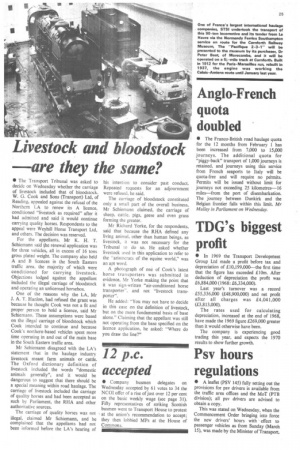Livestock and bloodstock —are they the same?
Page 27

If you've noticed an error in this article please click here to report it so we can fix it.
• The Transport Tribunal was asked to decide on Wednesday whether the carriage
of livestock included that of bloodstock. W. G. Cook and Sons (Transport) Ltd, of Reading, appealed against the refusal of the
Northern LA to renew its A licence, conditioned "livestock as required" after it had admitted and said it would continue carrying quality horses. Respondents to the appeal were Weyhill Horse Transport Ltd, and others. The decision was reserved.
For the appellants, Mr K. H. T. Schiemann said ;he renewal application was for three vehicles, all in excess of 16 tons gross plated weight. The company also held A and B licences in the South Eastern traffic area, the majority of which were conditioned for carrying livestock. Objections lodged against the appellant included the illegal carriage of bloodstock and operating an unlicensed horsebox.
One of the reasons why the LA, Mr J. A. T. Hanlon, had refused the grant was because he thought Cook was not a fit and proper person to hold a licence, said Mr Schiemann. These assumptions were based on the illegal carriage of bloodstock which Cook intended to continue and because Cook's northern-based vehicles spent more time operating in and out of the main base in the South Eastern traffic area.
Mr Schiemann disagreed with the LA's statement that in the haulage industry livestock meant farm animals or cattle.
The Oxford dictionary definition of livestock included the words "domestic animals generally", and it would be dangerous to suggest that there should be a special meaning within road haulage. The carriage of livestock included the carriage of quality horses and had been accepted as such by Parliament, the RHA and other authoritative sources.
The carriage of quality horses was not illegal, claimed Mr Schiemann., and he complained that the appellants had not been informed before the LA's hearing of his intention to consider past conduct. Repeated requests for an adjournment were refused, he said.
The carriage of bloodstock constituted only a small part of the overall business, Mr Schiemann claimed, the carriage of sheep, cattle, pigs, geese and even grass forming the greater.
Mr Richard Yorke, for the respondents, said that because the RHA defined any living animal, other than human beings, as livestock, it was not necessary for the Tribunal to do so. He asked whether livestock used in this application to refer to the -aristocrats of the equine world," was an apt word,
A photograph of one of Cook's latest horse transporters was submitted in evidence, Mr Yorke making the point that it was sign-written "air-conditioned horse transporter", and not "livestock transporter".
He added: "You may not have to decide in this case on the definition of livestock, but on the more fundamental basis of base alone." Claiming that the appellant was still not operating from the base specified on the licence application, he asked: "Where do you draw the line?"




























































































